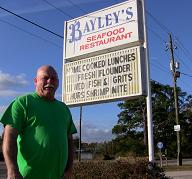Some Alabama fish populations increase dramatically after Gulf oil spill
[We have other reports of increases in fish populations following the Deepwater Horizon disaster. Desdemona has been assuming that the oil/dispersant mixture selectively removed predator species and, possibly, entire trophic levels from the ecosystem, allowing some prey species to reproduce with greatly reduced predation pressure. Time will tell.]
Dauphin Island–Since the oil spill in the Gulf of Mexico, marine scientists have come upon a surprising finding: more fish. Researchers at the Dauphin Island Sea report dramatic increases in some species. But as Gigi Douban reports, the seafood industry is responding to the news with a wave of skepticism. Click here to listen to the story Student researchers at the Dauphin Island Sea Lab load up a boat with some essentials. It’s about two hours to their destination in the Gulf of Mexico: T-35, so named because the water’s 35 meters deep. They’re going to collect thousands of samples of tiny arthropods (shrimp and crabs are an example), then count them at the lab. Counting marine life isn’t anything new. But when the BP oil spill hit, the Sea Lab ramped things up. They expected fewer sea creatures, a marine life wasteland. But instead, they found something very different. “For a number of species there was as much as 300% increases in the numbers of fishes we were catching,” says John Valentine, chair of university programs at the Dauphin Island Sea Lab. “Tiger sharks and sandbar sharks increased dramatically in the last six months or so. Croaker, spots, speckled trout, things like that are also increasing in abundance in our area.” Which begs the question: How, after more than 200 million gallons of oil are dumped into the ocean, do you end up with more fish? “It may just be that we’re far enough away from the injury site not to have detected the big impacts,” says Valentine. That is, the oiliest sections of the Gulf were near Louisiana, so most of those fish migrated to coastal Mississippi and Alabama. But perhaps the best explanation, Valentine says, is that for months after the spill no one was allowed to fish. The federal fishing closure lasted almost six months. And so, the theory goes, fish had a rare opportunity to thrive. But business owners in the gulf say the effects of the fishing closure haven’t been all good. Take Jimmy Bayley. He owns Bayley’s Seafood, half-way between Mobile and Dauphin Island. Bayley cooks mostly mullet and shrimp at his restaurant, which researchers say have remained steady or only slightly decreased. But he says in the months following the spill, he had trouble getting his hands on other staples like crab meat not because of any population shifts, but because no one was out crabbing. “I had crab meat, if you could find it. Problem was you couldn’t get nobody that was crabbing,” complains Bayley. …
